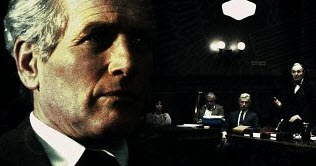The Verdict (1982)

View Movie Trailer and Review Original Movie Comments
Relevant to this Segment
- At the beginning of the movie Frank Galvin visits funerals and checks obituaries. Is his conduct ethical? Is such ambulance chasing common? Is it ethical?
Our thoughts: How can we say this unambiguously? Yes!!! The actions of the attorney are classic ambulance-chasing techniques. Completely unethical. Unfortunately, this still happens. While it isn't really common, when it does occur it is overlooked by most bar associations (although they might argue with that assessment).
- After paying a visit to his comatose client in the hospital, and taking Polaroid pictures of her for the jury to consider, Galvin attends a settlement meeting where he rejects the offer of $210,000. Were his actions ethical?
Our thoughts: Again, even though his motives were pure, they were unethical. He had an obligation to inform his clients (the sister and brother-in-law of the comatose woman) that an offer was made, and the decision would have been their's to make. Galvin could advise them not to take it, but for him to make the decision on his own without even informing them was not just unethical. It was malpractice.
- The critical scene in the movie is when a former admittance nurse is called to testify. Watch carefully as Galvin asks questions. The scene is very accurate as to strategy and procedure for admitting evidence. In fact, you may be surprised at the question that Galvin does not ask. There is a reason for that. Why did he not ask the question that the opposing attorney does, for himself?
Our thoughts: When the admitting nurse is on the witness stand, Frank Galvin asks her several questions, including the critical one. What did the patient tell you about how long it had been since she had eaten? The answer the nurse gives is "1 hour." This contradicts the admittance form that we learned about earlier in the film, which stated that it had been "9 hours" since she had eaten. However, Galvin lets it go at that and sits down. It is the defense attorney who asks the question, "And how is it that you remember what you entered on an obscure document all these years later?" The answer sends shock waves: "Because I kept a copy. I thought I might need it."
Before the witness-nurse can produce the paper from her bag the defense attorney objects to the testimony (even though it was in response to his own question). Eventually he gets the testimony thrown out, including the copy of the form. Back to our question. Why didn't Galvin ask her about the copy? Why did he take the chance that the other attorney to ask "how she remembered?" The answer is simple: Galvin knew that the copy would not be admissible. If he was the one who elicited the information about the copy of the admittance form in front of the jury he would have risked an almost certain mistrial. Since the information was elicited from the defense attorney instead, the chance of a mistrial based on the jury's knowledge of the copy was minimized.
Bonus note: The defense attorney broke the cardinal rule of examination. Never ask a question that you don't know the answer to!
Another bonus note: Did you catch what rule prevented the copy being admitted to contradict the original admittance form? It was the best-evidence rule!
- Finally, watch the back-and-forth between the attorneys and the judge following the nurse's testimony. It is full of procedure. Paralegals who know procedure can be of great assistance to their attorney. Was the judge correct in his ruling on the testimony? What grounds could Galvin have argued that might have affected the judge's ruling?
Our thoughts: The judge was probably correct in ruling that the copy could not be used to contradict the original. However, if Galvin had used a different strategy he might have been able to get it in. What he might have done was to attempt to destroy the credibility of the original document using the nurse's testimony to attest to the fact that it had been altered, thereby making the copy of the original the "best evidence" available. However, it was very late in the trial and the judge may not have allowed such testimony after the evidence had already been admitted (and not objected to by Galvin) earlier in the trial. In any case, the effect of the surprise witness would have been lost.
The judge also ruled that the nurse's entire testimony was inadmissible. The judge was on shakier grounds here, although Galvin did not put up much of an objection. He probably should have objected that even though the document was not admissible, her testimony as to the information she obtained from the patient should have been allowed, leaving it for the jury to decide which "fact" was true: the original admittance form or the nurse's testimony. (Remember, the jury is the decider of fact.)
Final bonus note: When the judge instructs the jury to "disregard the testimony of the nurse," it is a classic example that you "can't un-ring a bell." However, there wasn't much the defense attorney could do. Fortunately for the plaintiff, the information that the judge tried to get the jury to not consider was presented as a result of the defense attorney's line of questioning, and thus the "wound" was self-inflicted. They could not base a mistrial on their own mistake. There is a general rule that a party can not benefit from its own missteps.
Classic Film Recommendation
- The Paper Chase (1973) starring Timothy Bottoms, John Houseman, and Edward Hermann. Great movie about the trials (figuratively) and tribulations of first-year Harvard Law School students.

